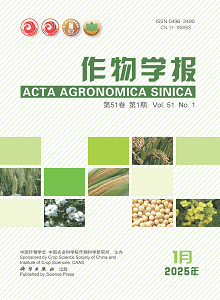Effects of soaking seeds with MT and EBR on germination and seedling growth in buckwheat under salt stress
引用次数: 1
Abstract
: Soil salinization is an important limiting factor affecting seed germination, emergence, and growth of crop seeds. It is of great significance to explore the relieving effect of exogenous hormones on buckwheat seed germination and seedling growth under salt stress. This experiment was conducted to study the effects of melatonin (MT) and 2,4-epbrassinolide (EBR) on seed germination, seedling growth, antioxidant enzyme activity, and osmotic regulation substances of buckwheat varieties Xinong 9976 under different salt concentration stress using petri dish germination and pot germination. The results showed that salt stress increased the malondialdehyde (MDA) content, soluble sugar content, and antioxidant enzyme (SOD, POD, CAT) activities of buckwheat seeds and seedling leaves, decreased the germination potential, germination rate, and seedling rate of buckwheat seeds, and significantly decreased the germ length, radicle length, and seedling height of buckwheat seeds. MT and EBR soaking buckwheat seeds could effectively alleviate the harm of salt stress. Compared with the control, the germination potential, germination rate, and seedling formation rate of buckwheat seeds were increased by 14.9%–33.3%, 11.5%–27.3%, and 20.0%–46.2%, respectively. It significantly increased the radicle length, embryo length, embryo fresh weight, dry weight, seedling height, seedling fresh weight, and dry weight of buckwheat seeds, and significantly increased the soluble sugar content and the activities of SOD, POD, and CAT in buckwheat seeds and seedling leaves, and decreased MDA content. In conclusion, MT and EBR soaking can promote the germination and seedling growth of buckwheat seeds under salt stress, and improve the salt resistance of buckwheat by improving the protective enzyme activity of buckwheat seeds, reducing the accumulation of reactive oxygen species, and increasing the content of osmotic regulation substances.MT和EBR浸泡种子对盐胁迫下荞麦发芽和幼苗生长的影响
:土壤盐碱化是影响作物种子发芽、出苗和生长的重要限制因素。探讨外源激素对盐胁迫下荞麦种子萌发和幼苗生长的缓解作用具有重要意义。本试验采用培养皿和盆栽两种方法,研究了褪黑素(MT)和2,4-丙二醇(EBR)对不同盐胁迫下荞麦品种西农9976种子发芽、幼苗生长、抗氧化酶活性和渗透调节物质的影响。结果表明,盐胁迫增加了荞麦种子和幼苗叶片的丙二醛(MDA)含量、可溶性糖含量和抗氧化酶(SOD、POD、CAT)活性,降低了荞麦种子的发芽势、发芽率和成苗率,并显著降低了荞麦种的芽长、胚根长和苗高。MT和EBR浸种荞麦能有效减轻盐胁迫的危害。与对照相比,荞麦种子的发芽势、发芽率和成苗率分别提高了14.9%-33.3%、11.5%-27.3%和20.0%-46.2%。显著增加荞麦种子的胚根长度、胚长、胚鲜重、干重、苗高、苗鲜重和干重,显著提高荞麦种子和幼苗叶片中可溶性糖含量和SOD、POD、CAT活性,降低MDA含量。总之,MT和EBR浸泡可以通过提高荞麦种子的保护酶活性、减少活性氧的积累、增加渗透调节物质的含量,促进荞麦种子在盐胁迫下的发芽和幼苗生长,提高荞麦的耐盐性。
本文章由计算机程序翻译,如有差异,请以英文原文为准。
求助全文
约1分钟内获得全文
求助全文
来源期刊

作物学报
Agricultural and Biological Sciences-Agronomy and Crop Science
CiteScore
1.70
自引率
0.00%
发文量
89
期刊介绍:
The major aims of AAS are to report the progresses in the disciplines of crop breeding, crop genetics, crop cultivation, crop physiology, ecology, biochemistry, germplasm resources, grain chemistry, grain storage and processing, bio-technology and biomathematics etc. mainly in China and abroad. AAS provides regular columns for Original papers, Reviews, and Research notes. The strict peer-review procedure guarantees the academic level and raises the reputation of the journal. The readership of AAS is for crop science researchers, students of agricultural colleges and universities, and persons with similar academic level.
 求助内容:
求助内容: 应助结果提醒方式:
应助结果提醒方式:


